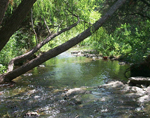Wetland Functions and Values

Lake Creek in Travis County, prior to channelization.
Photo courtesy Jennifer Key, TPWD 2002, Travis County
What's the difference between wetland functions and wetland values?
Wetland functions are those processes that wetlands perform independent of
human opinion, such as nutrient cycling, floodflow
alteration, sediment stabilization,
and providing plant and animal habitat. Wetland values are a measurement of
the benefit these wetland functions provide to society. For example, wetlands
are valued in different degrees for their ability to improve water quality,
provide economic benefits for wetland-dependent businesses, help in stabilizing
global levels of carbon dioxide, reduce flood damage, and provide recreation
opportunities.
Nutrient cycling: this is a measure of abiotic and biotic processes that
convert nutrients from one form to another. A recycling process, nutrient
cycling in wetlands facilitates detritus turnover, releasing nutrients
for uptake by plants.
Floodflow alteration: this is an important function of mainly riparian wetlands, and relates to a wetland's capacity to capture and temporarily store excess water in the landscape. Generally, the source of this water is overbank flooding from an adjacent stream or river, but can also come from runoff from adjacent upland areas. As overbank flow or upland surface runoff is detained in the wetland, the flood wave is reduced, which can result in reduced downstream peak flows.
Sediment stabilization: as overland flow enters a wetland from an adjacent stream, the flat topography and roughness of the wetland causes the water to slow, and thereby drop inorganic particles out of the water column.
Plant and animal habitat: several wetlands experience wet/dry cycles throughout the year, providing varied structure in plant and animal habitat.